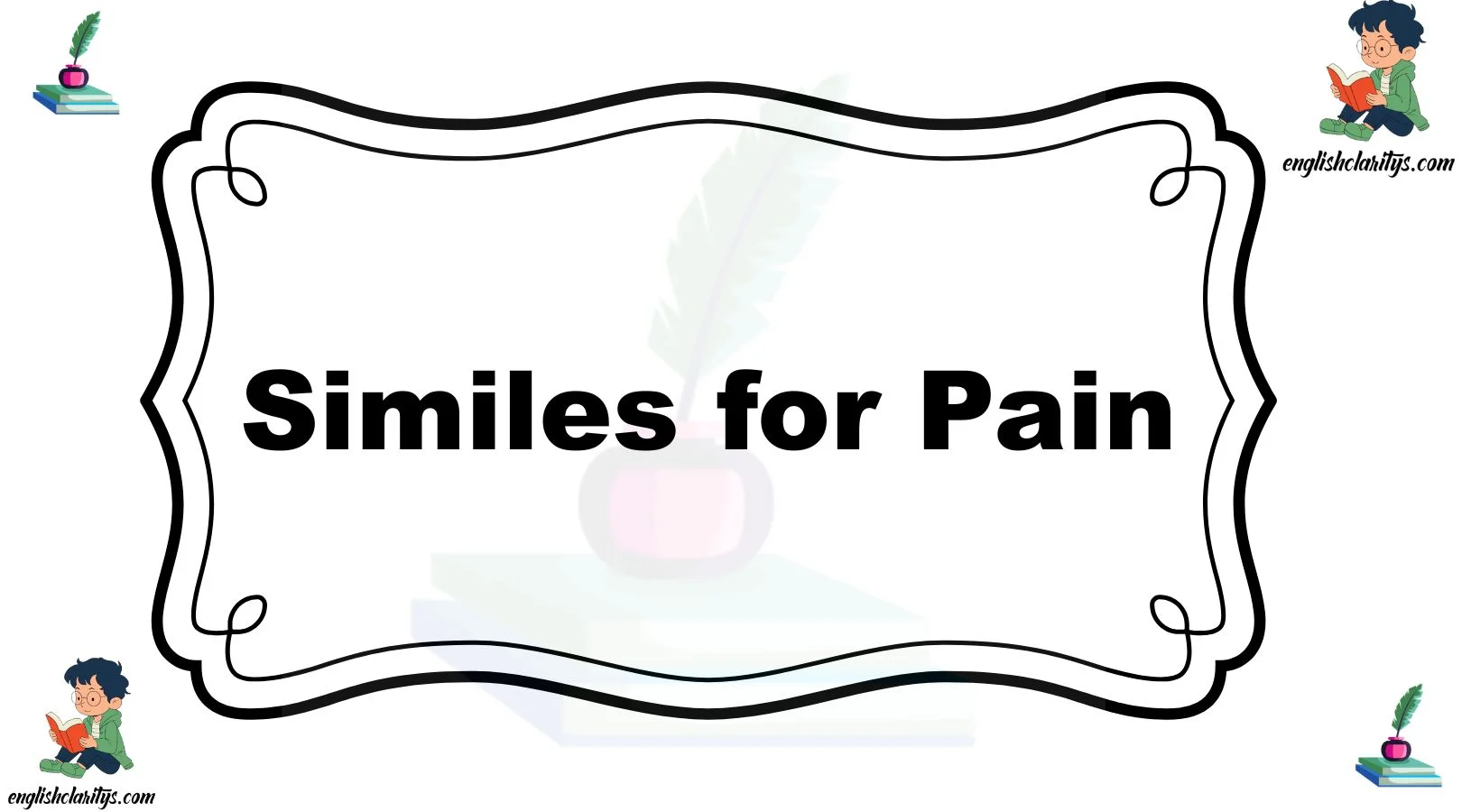Finding the right words to express pain—especially someone else’s—can feel overwhelming. Whether you’re offering comfort, writing a message, or simply trying to articulate your own experience, how you phrase it matters. Using similes allows you to paint vivid emotional pictures that feel personal, sincere, and thoughtful.
This guide offers 25 carefully crafted similes for pain to help you express care with warmth and empathy. Each one is explained in detail with examples, tone, and best usage suggestions—ideal for writing, conversation, or emotional support. Words can heal, and these similes are crafted to do just that.
What Does “Similes for Pain” Mean?
A simile is a figure of speech that compares one thing to another using “like” or “as.” When used for pain, it describes emotional or physical discomfort through relatable, often visual comparisons. This helps the listener or reader truly feel the depth of what someone’s going through, making your message more empathetic and genuine.
When to Use “Similes for Pain”
Use similes for pain when:
- You’re writing a message of empathy or support
- You want to express your own emotions more vividly
- You’re crafting a poem, letter, blog post, or story
- You’re helping children or students learn to articulate feelings
Pros or Cons
Pros:
- Makes language more relatable and emotional
- Helps readers or listeners visualize and connect with the message
- Enhances creative writing and storytelling
- Builds stronger emotional impact
Cons:
- Overuse can feel dramatic or exaggerated
- Might confuse the listener if the simile is too obscure
- Needs tone awareness to match the emotional context prope
1. Like a knife twisting in the heart
Definition: Describes a sharp emotional or physical pain that worsens over time.
Explanation: Often used when someone is experiencing heartbreak, betrayal, or deep grief.
Example Scenario: “When she heard the news, it felt like a knife twisting in her heart.”
Best Use: Writing about emotional betrayal or devastating news.
Tone: Intensely emotional, dramatic.
Other ways to say it:
- Like being stabbed with memories
- Like a blade under the skin
- Like an invisible wound
2. Like a storm raging in the chest
Definition: Describes internal emotional chaos and overwhelming pain.
Explanation: Best used for anxiety, panic, or grief that feels all-consuming.
Example Scenario: “His words hit me like a storm raging in my chest.”
Best Use: Emotional overwhelm, panic attacks, heartbreak.
Tone: Powerful, descriptive, heartfelt.
Other ways to say it:
- Like thunder shaking your ribs
- Like waves crashing inside
- Like a hurricane of emotion
3. Like walking on broken glass
Definition: Describes painful progress or every step causing hurt.
Explanation: Symbolizes a situation where continuing feels painful or dangerous.
Example Scenario: “Talking to him again was like walking on broken glass.”
Best Use: Emotional conflict, toxic relationships.
Tone: Fragile, cautious, emotional.
Other ways to say it:
- Like tiptoeing through pain
- Like bleeding with every step
- Like dragging your soul barefoot
4. Like a shadow that never leaves
Definition: A dull, constant pain that doesn’t go away.
Explanation: Often used for long-term emotional pain or chronic grief.
Example Scenario: “Her absence was like a shadow that never leaves.”
Best Use: Long-lasting sorrow, grief.
Tone: Melancholic, deep.
Other ways to say it:
- Like dusk that never lifts
- Like a weight on your back
- Like sadness sewn into your skin
5. Like fire burning under the skin
Definition: Describes a sharp, intense, or searing pain.
Explanation: Often used for anger or physical suffering.
Example Scenario: “The guilt burned like fire under my skin.”
Best Use: Intense emotional or physical discomfort.
Tone: Fiery, raw.
Other ways to say it:
- Like heat you can’t escape
- Like boiling inside
- Like being scorched silently.
6. Like thunder pounding in your skull
Definition: Describes a blinding, intense pain, often emotional or headache-related.
Explanation: Suggests the feeling of internal noise or turmoil that won’t stop.
Example Scenario: “The stress was like thunder pounding in my skull.”
Best Use: Headaches, anxiety, emotional overload.
Tone: Overwhelmed, chaotic.
Other ways to say it:
- Like drums in your head
- Like lightning behind your eyes
- Like an earthquake in your mind
7. Like being buried under bricks
Definition: Feeling emotionally crushed or suffocated.
Explanation: Implies a heavy, unbearable emotional weight.
Example Scenario: “Losing him felt like being buried under bricks.”
Best Use: Deep grief, trauma.
Tone: Heavy, hopeless.
Other ways to say it:
- Like a mountain on your chest
- Like drowning in weight
- Like pressure with no escape
8. Like screaming into a void
Definition: Pain tied to feeling unheard or alone.
Explanation: Expresses helplessness when no one seems to understand or care.
Example Scenario: “I kept trying to explain, but it felt like screaming into a void.”
Best Use: Loneliness, emotional neglect.
Tone: Isolated, raw.
Other ways to say it:
- Like silence that echoes
- Like a whisper swallowed
- Like talking to shadows
9. Like an open wound that won’t heal
Definition: Pain that is ongoing, vulnerable, and easily triggered.
Explanation: Used when old pain keeps resurfacing.
Example Scenario: “Her words reopened a wound that never healed.”
Best Use: Long-term emotional trauma.
Tone: Tender, vulnerable.
Other ways to say it:
- Like a scab torn again
- Like a bruise pressed too hard
- Like skin without protection
10. Like a scream trapped in your throat
Definition: Describes internalized pain or emotions one can’t express.
Explanation: Often associated with repressed trauma or grief.
Example Scenario: “It felt like a scream was always trapped in my throat.”
Best Use: Emotional suppression, silence.
Tone: Tense, anguished.
Other ways to say it:
- Like a voice choked back
- Like crying without sound
- Like words locked inside
11. Like ice spreading through your chest
Definition: Emotional pain that feels cold, paralyzing, or numbing.
Explanation: Captures the shock or aftermath of tragic news or heartbreak.
Example Scenario: “When I saw him leave, it was like ice spreading through my chest.”
Best Use: Emotional numbness or heartbreak.
Tone: Still, chilling.
Other ways to say it:
- Like frost on your heart
- Like winter in your soul
- Like being frozen inside
12. Like drowning in silence
Definition: Describes loneliness or deep inner pain without words.
Explanation: You’re surrounded by quiet, but inside you’re suffocating.
Example Scenario: “After the funeral, I was drowning in silence.”
Best Use: Grief, isolation, depression.
Tone: Quiet, intense.
Other ways to say it:
- Like sinking with no rescue
- Like being alone in a storm
- Like silence swallowing you
13. Like thorns inside the heart
Definition: Pain that’s small but persistent and piercing.
Explanation: Describes ongoing emotional discomfort, especially regret or guilt.
Example Scenario: “Every memory was like a thorn in my heart.”
Best Use: Regret, sorrow, small betrayals.
Tone: Tender, sharp.
Other ways to say it:
- Like pins in your soul
- Like little knives
- Like barbed memories
14. Like fireflies trapped in a jar
Definition: Emotional pain from feeling trapped, despite having light inside.
Explanation: Great for describing hope stifled by emotional limitations.
Example Scenario: “My dreams felt like fireflies trapped in a jar.”
Best Use: Lost potential, emotional suffocation.
Tone: Poetic, bittersweet.
Other ways to say it:
- Like stars caged in glass
- Like wings clipped
- Like bright things dimmed
15. Like waves crashing over and over
Definition: Repetitive pain that comes in emotional cycles.
Explanation: Captures the return of grief, anxiety, or trauma.
Example Scenario: “Some days the pain comes like waves crashing over and over.”
Best Use: Cyclical sadness, grief.
Tone: Rhythmic, emotional.
Other ways to say it:
- Like tides of sorrow
- Like reliving it each day
- Like oceans of ache
16. Like needles under your skin
Definition: Irritating or sharp pain, either emotional or physical.
Explanation: Suggests anxiety or discomfort that’s subtle but constant.
Example Scenario: “Her criticism felt like needles under my skin.”
Best Use: Anxiety, passive-aggressive pain.
Tone: Sharp, subtle.
Other ways to say it:
- Like crawling nerves
- Like prickles of stress
- Like invisible stings
17. Like glass shattering inside
Definition: Sudden, breaking emotional pain.
Explanation: Symbolizes the feeling when something you believed in breaks.
Example Scenario: “When I saw the truth, it was like glass shattering inside.”
Best Use: Betrayal, shocking realizations.
Tone: Shocking, painful.
Other ways to say it:
- Like a mirror cracking
- Like trust breaking apart
- Like hearts splintering
18. Like a fire that won’t go out
Definition: Passionate or painful emotion that burns endlessly.
Explanation: Describes enduring pain tied to strong emotions.
Example Scenario: “The guilt was like a fire that wouldn’t go out.”
Best Use: Obsession, regret, unresolved conflict.
Tone: Burning, obsessive.
Other ways to say it:
- Like eternal embers
- Like smoldering memories
- Like a never-ending blaze
19. Like a ghost haunting every step
Definition: Past pain that still follows and affects the present.
Explanation: Used for memories or trauma that linger.
Example Scenario: “His absence was like a ghost haunting every step.”
Best Use: Grief, trauma.
Tone: Eerie, melancholic.
Other ways to say it:
- Like footprints behind you
- Like voices in the dark
- Like memories you can’t escape
20. Like being lost in a maze of thoughts
Definition: Describes pain caused by confusion or overthinking.
Explanation: Good for anxiety and emotional disorientation.
Example Scenario: “My mind was like a maze I couldn’t get out of.”
Best Use: Mental health struggles, anxiety.
Tone: Frustrated, tangled.
Other ways to say it:
- Like chasing shadows
- Like thoughts running wild
- Like loops with no end
21. Like salt on an open wound
Definition: Making existing pain worse through reminders or insensitivity.
Explanation: Used when someone unintentionally or intentionally adds to your pain.
Example Scenario: “His joke felt like salt on an open wound.”
Best Use: Insensitive comments, emotional triggers.
Tone: Stinging, raw.
Other ways to say it:
- Like pouring acid
- Like rubbing it in
- Like reopening the pain
22. Like being forgotten by the world
Definition: Describes abandonment or deep loneliness.
Explanation: Often used for depression or isolation.
Example Scenario: “She felt like the world had forgotten her.”
Best Use: Mental health, solitude.
Tone: Empty, heavy.
Other ways to say it:
- Like fading from view
- Like being invisible
- Like silence growing roots
23. Like carrying a storm inside
Definition: Emotional pain that feels like it’s waiting to explode.
Explanation: Reflects repressed emotions or inner turmoil.
Example Scenario: “He smiled, but he was carrying a storm inside.”
Best Use: Suppressed emotions, emotional breakdowns.
Tone: Intense, building.
Other ways to say it:
- Like thunder in the chest
- Like lightning waiting
- Like a dam about to break
24. Like a song stuck on a sad note
Definition: Emotional pain that repeats and won’t shift.
Explanation: Highlights emotional patterns or memories that won’t move on.
Example Scenario: “My heart kept playing a sad note on loop.”
Best Use: Repetitive sadness, emotional loops.
Tone: Melancholy, poetic.
Other ways to say it:
- Like a scratched record
- Like a tune in your bones
- Like humming grief
25. Like rain falling inside your chest
Definition: Gentle but persistent emotional sadness.
Explanation: Often used for quiet grief or mild depression.
Example Scenario: “I laughed, but it still felt like rain was falling in my chest.”
Best Use: Mild sorrow, everyday grief.
Tone: Soft, emotional.
Other ways to say it:
- Like clouds in the lungs
- Like fog over your heart
- Like inner drizzle.
Conclusion:
Understanding and expressing pain through similes can transform a simple statement into a deeply moving message. Similes allow us to communicate pain with warmth, empathy, and vivid imagery, making it easier for others to connect with our feelings. Whether it’s the sharpness of “needles under your skin” or the heaviness of “being buried under bricks,” these comparisons give voice to emotions often hard to articulate.
When you use these similes thoughtfully, they help not only in expressing your own experience but also in showing care to someone else who may be hurting. The tone and context matter a lot—choosing the right simile can make your message feel personal, sincere, and compassionate. Remember, words are powerful tools for healing and connection, and similes for pain are no exception.
MCQs:
1. What is the primary purpose of using similes for pain?
a) To confuse the reader
b) To express pain with vivid imagery
c) To avoid talking about pain
d) To exaggerate pain
Answer: b) To express pain with vivid imagery
2. Which phrase best describes pain that feels heavy and suffocating?
a) Like thunder pounding in your skull
b) Like being buried under bricks
c) Like fireflies trapped in a jar
d) Like rain falling inside your chest
Answer: b) Like being buried under bricks
3. What tone does the simile “Like ice spreading through your chest” convey?
a) Warm and happy
b) Chilling and numbing
c) Joyful and light
d) Playful and fun
Answer: b) Chilling and numbing
4. Which simile would best express repressed emotions?
a) Like a scream trapped in your throat
b) Like waves crashing over and over
c) Like salt on an open wound
d) Like fire that won’t go out
Answer: a) Like a scream trapped in your throat
5. When is it best to use the simile “Like salt on an open wound”?
a) When describing physical pain
b) When describing worsening emotional pain
c) When feeling happy
d) When feeling sleepy
Answer: b) When describing worsening emotional pain
6. The simile “Like a ghost haunting every step” refers to:
a) Feeling followed by past pain
b) Feeling excited
c) Feeling joyful
d) Feeling relaxed
Answer: a) Feeling followed by past pain
7. What kind of pain does “Like needles under your skin” describe?
a) Intense but fleeting pain
b) Subtle, irritating discomfort
c) Complete numbness
d) Joy and happiness
Answer: b) Subtle, irritating discomfort
8. Which simile best suits someone experiencing repetitive grief?
a) Like waves crashing over and over
b) Like ice spreading through your chest
c) Like glass shattering inside
d) Like fireflies trapped in a jar
Answer: a) Like waves crashing over and over
9. The tone of “Like fireflies trapped in a jar” is:
a) Dark and angry
b) Poetic and bittersweet
c) Loud and chaotic
d) Cheerful and bright
Answer: b) Poetic and bittersweet
10. “Like trying to hold water in your hands” conveys:
a) Success in controlling emotions
b) Hopelessness in trying to control something
c) Physical strength
d) Happiness
Answer: b) Hopelessness in trying to control something
11. What is a key feature of a simile?
a) Uses “and” or “but”
b) Uses “like” or “as” to compare
c) Is always a question
d) Always rhymes
Answer: b) Uses “like” or “as” to compare
12. Which simile conveys feeling emotionally numb?
a) Like ice spreading through your chest
b) Like thorns inside the heart
c) Like a scream trapped in your throat
d) Like waves crashing over and over
Answer: a) Like ice spreading through your chest
13. “Like a song stuck on a sad note” refers to:
a) Joyful music
b) Repetitive emotional pain
c) Silence
d) Anger
Answer: b) Repetitive emotional pain
14. The simile “Like glass shattering inside” best expresses:
a) Sudden emotional breaking
b) Calmness
c) Happiness
d) Silence
Answer: a) Sudden emotional breaking
15. Which simile suggests hidden or quiet suffering?
a) Like a whisper of a scream
b) Like thunder pounding in your skull
c) Like being buried under bricks
d) Like fire that won’t go out
Answer: a) Like a whisper of a scream
FAQs:
1. What is a simile?
A simile is a figure of speech that compares two different things using the words “like” or “as” to create vivid imagery.
2. Why use similes to describe pain?
Similes help make abstract or complex feelings like pain more relatable and understandable by comparing them to familiar experiences.
3. Can similes for pain be used in everyday conversations?
Yes, similes can soften the expression of pain, making it easier to communicate difficult emotions in both personal and professional settings.
4. How do I choose the right simile for my pain?
Consider the intensity, type, and context of your pain. Also, think about your audience and the tone you want to convey—whether gentle, intense, or poetic.
5. Are similes the same as metaphors?
No, similes explicitly use “like” or “as” for comparison, while metaphors state one thing is another without those words.




